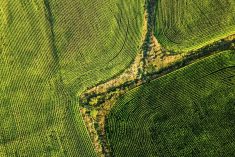Glacier FarmMedia—As G7 leaders convened to mull over the world’s problems at their summit in Kananaskis this week, a much lower-profile international gathering here focused on what many believe is a solution to most of them.
Agriculture didn’t make the G7 agenda. It was pushed aside by more pressing issues like international security, economics, technology global migration and trade.
But the forum hosted by the Inter-American Institute for Cooperation on Agriculture (IICA) and the International Fund for Agricultural Development (IFAD) was designed to ensure agriculture and food stays on world leaders’ radar.
Read Also

Federal budget shows remaining disconnect between agriculture, policymakers, panelists say
Canada’s agriculture sector is still disconnected from policymakers in some ways, say panelists at a CAPI webinar
“Agriculture has to be an instrument of peace,” IICA director general Manuel Otero said in an interview on the opening day of the Americas AgForum. “In all of these issues, agriculture is at the centre of the solutions, so implicitly or explicitly G7 leaders have to discuss the role of agriculture.”
Climate, nutritionally smart
IICA, founded in 1942, focuses on fostering rural and agricultural development among its 34 member states across the Americas. It works to increase the sector’s contributions to rural well -being, food security and economic growth through the bioeconomy and trade.
Otero told his audience of about 150 delegates in the room and 800 watching virtually that meeting the world’s food needs over the next 40 years will be a multidimensional challenge that involves grappling with production challenges brought about by climate change as well as navigating the simultaneous crises of undernutrition and obesity.
“It is not just climate smart any more, it has to be nutritionally smart too,” he said.
Otero called for policies that enable small-holder farmers to adopt new technologies such as digital agriculture to grow productivity, and which stabilize rural economies by keeping farmers on the land. That has a stabilizing effect on cities too.
“Every time a producer becomes a consumer, we face a problem,” Otero said, noting outward migration from rural areas creates unsustainable pressure on urban infrastructure and food systems.
Speakers said making it possible for people to thrive in rural communities requires major investments in rural connectivity to make productivity-enhancing digital technology more accessible.
Need for timely innovation
The food system also needs more entrepreneurs and investment capital at all levels to bring new ideas to market, said Justine Hendricks, president and CEO of Farm Credit Canada.
“We’ve been hearing more and more the need to accelerate innovation, the time to get innovation through to commercialization is certainly too long in Canada,” she said. “Whether you are early stage or all the way through to a growth stage, some of the work we’ve done shows that in the Canadian ecosystem, there were gaps all along the way.”
FCC has recently dedicated $2 billion in spending over the next five years to support Canada’s innovation pipeline.
“Canada has got really outstanding innovation hubs, our education system is second to none, we’ve got land, we’ve got water we’ve got what the world wants,” she said. “Canada has this generational opportunity. We just need to bring those things closer together.”
Plus, it requires building a foundation of trust with consumers beneath the sector’s never-ending drive to innovate.
Lisa Bishop-Spencer, executive director for the Canadian Centre for Food integrity, said public trust in the food system has been eroded in recent years, but Canada doesn’t face that trend alone.
“This is common across many countries in the Americas,” she said.
“What we know is that people trust farmers, they trust individuals. Where they start to lose that trust is when it starts to become more institutional in its setting,” she said.
“’Innovation’ is a wonderful word and it means so much to our industry, but consumers are afraid of innovation,” Bishop-Spencer said.
“When you position it terms of outcomes that’s when it becomes more resonate for people,” she said. “People understand the values behind the little red barn and little green tractor are still behind what do no matter what scale we do it at.”















